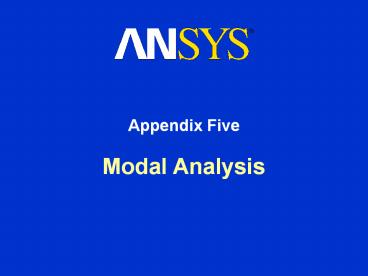Modal Analysis PowerPoint PPT Presentation
Title: Modal Analysis
1
Modal Analysis
- Appendix Five
2
Basics of Free Vibration Analysis
- A free vibration analysis (a.k.a. modal or normal
modes analysis) is performed to obtain the
natural frequencies and mode shapes of a
structure - Free Vibration analysis does not consider the
response of the structure under dynamic loads but
just solves for the natural frequencies. A free
vibration analysis is usually the first step
before solving more complicated dynamic problems. - A free vibration analysis is a subset of the
general equation of motion
3
Basics of Free Vibration Analysis
- In free vibration analysis, the structure is
assumed to be linear, so the response is assumed
to be harmonic - where fi is the mode shape (eigenvector) and wi
is the natural circular frequency for mode i. - By substituting this value in the earlier
equation, the following is obtained - Noting that the solution fi 0 is trivial, wi is
solved for
4
Requesting Results
- The corresponding ANSYS commands for the
Frequency Finder branch are as follows - If Frequency Finder branch is present,
ANTYPE,MODAL is set - The number of modes is set with the nmodes
argument, and the beginning and ending search
frequencies are specified with freqb and freqe of
the MODOPT,,nmodes,freqb,freqe command - All modes are expanded via the MXPAND command.
To save disk space and calculation times, the
element solution option of MXPAND is not turned
on unless stress or strain results are requested.
5
Solution Options
- For a regular modal analysis, none of the
solution options except for Solver Type have
much effect - Large Deflection and Weak Springs are meant
for static analysis cases and should not be
changed. - Solver Type can be set to Direct or
Iterative - Program Controlled or Direct result in the
Block Lanczos eigenvalue extraction method with
the sparse direct equation solver (MODOPT,LANB
and EQSLV,SPARSE). This is the most robust
eigensolver, as it handles small large models
and beam, shell, or solid meshes, so it is the
default option. - Iterative results in the PowerDynamics solution
method, which is a combination of the subspace
eigenvalue extraction method with the PCG
equation solver (MODOPT,SUBSP and EQSLV,PCG).
The PowerDynamics eigensolver can be efficient
for large models of solid elements, when
requesting only a few modes.
6
Prestressed Modal Analysis
- For prestressed modal analysis, Simulation
performs the two necessary iterations internally - A linear static analysis with PSTRES,ON is run
- A modal analysis is then run right afterwards
with PSTRES,ON to consider prestress effects
7
Prestressed Modal Analysis
- Other items useful for ANSYS users to keep in
mind - No large-deflection prestress effects are
currently supported in Simulation, so enabling
the Large Deflection On in the Solution branch
is not permitted. - The equation solver for the static analysis and
the eigensolver for the modal analysis currently
cannot be independently set. Both will be
affected by the Solver Type setting in the
Solution branch. - If a Point Mass is present, rigid-body modes may
be introduced in a prestressed modal analysis.
This is due to the fact that the RBE3-type of
surface constraint defined with CONTA174 and
TARGE170 introduce 6 DOF but the MASS21 element
has no rotary inertial terms (3 DOF). - The user can usually ignore these rigid-body
modes, as they are associated with the MASS21
elements (verify by checking displacement scale
of these mode shapes). - No such problems exist for a regular modal with
Point Masses.
8
(No Transcript)

